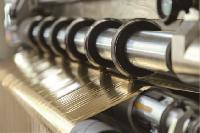Innovative application of ribbon slitting machine in the production of new energy battery labels

Posted by sebrina
from the Business category at
21 Jul 2025 01:21:00 am.
1. Adapt to high weather-resistant label materials
• Challenge: New energy battery labels need to withstand extreme environments such as high temperatures, electrolyte corrosion, and ultraviolet rays.
• Innovative Applications:
◦ The slitter can precisely cut chemically resistant ribbons (such as coated ribbons or resin-based ribbons) to ensure that the label does not fade in the electrolyte environment.
◦ Support slitting of high-temperature resistant materials (such as polyimide labels) to meet the needs of high-temperature operating scenarios of batteries.
2. High-precision slitting and edge processing
• Challenge: Battery labels require extremely tight tolerances (±0.1mm) to avoid print shifts or poor fit.
• Innovations:
◦ Laser-guided slitting or CNC slitting system is used to achieve micron-level accuracy.
▪ Automatic tension control reduces the tensile deformation of the material during slitting, and ensures the perfect fit between the label and the cell.
3. Intelligent and automated integration
• Innovative Applications:
◦ The integrated visual inspection system monitors the slitting quality in real time and automatically rejects defective ribbon segments.
◦ Connected to the MES system via IoT, the slitting parameters (width, tension) and the subsequent printing/labeling process can be co-optimized.
4. Environmental and sustainability improvements
• Industry demand: The new energy industry emphasizes green production.
• Innovative solutions:
◦ The slitter is compatible with solvent-free ribbons or bio-based materials to reduce VOC emissions.
◦ Automatic recycling system for slitting waste to improve material utilization.
5. Customized slitting solutions
• Application Scenarios:
◦ For different shapes such as cylindrical batteries and pouch batteries, the slitter can quickly switch between special-shaped ribbons (such as narrow or segmented ribbons).
◦ Support variable width slitting of 2D code/barcode labels to meet battery traceability needs.
6. Improve printing efficiency and durability
• Innovative Design:
◦ The slitted ribbon is matched with a high-speed printhead (such as a thermal transfer printer) to increase the batch printing speed of battery labels.
◦ Optimize ribbon coating uniformity to ensure that the label does not blur or fall off during the battery lifecycle.
7. Security Compliance Assurance
• New energy standards: UL/CE certification, flame retardant requirements, etc.
• Slitter Role:
◦ The slitting process controls the consistency of the thickness of the ribbon to avoid uneven flame retardant coating of the label after printing.
◦ Cooperate with halogen-free material slitting to meet environmental protection regulations.
Case Reference
• A power battery manufacturer: After adopting a ribbon slitting machine equipped with AI deviation correction system, the label defect rate decreased by 60% and the production efficiency increased by 30%.
• Energy storage battery labeling: Solve the problem of embrittlement of outdoor energy storage batteries by slitting low-temperature resistant ribbons (-40°C).
Future Trends
• Composite slitting technology: slitting multiple layers of materials (such as label + insulating film) at the same time.
• Digital twin applications: Virtual slitting simulation optimizes actual production parameters.
Through the above innovations, the ribbon slitting machine has been upgraded from a simple processing equipment to one of the core links of new energy battery label production, which directly affects the reliability, production efficiency and compliance of the label.
Tags: ribbon slitting machine
0 Comments



